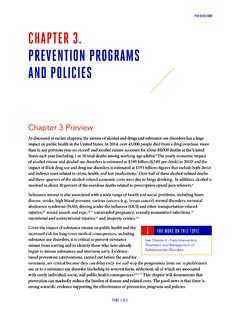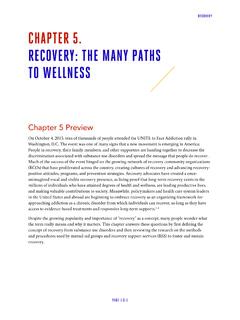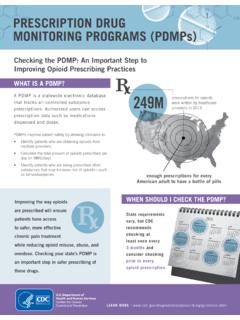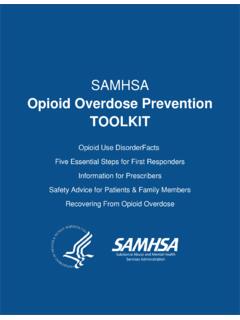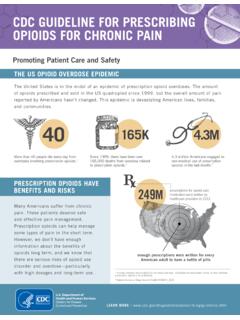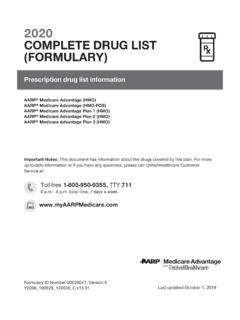Transcription of Facing Addiction in America: The Surgeon General’s ...
1 Facing Addiction IN AMERICAThe Surgeon General sSpotlight on Department of Health & Human ServicesFacing Addiction in America The Surgeon General s Spotlight on OpioidsSUGGESTED Department of Health and Human Services (HHS), Office of the Surgeon General, Facing Addiction in America: The Surgeon General s Spotlight on , DC: HHS, September MORE INFORMATIONFor more information about the Surgeon General s Spotlight on Opioids or to download copies, visit of trade names and specific programs are for identification only and do not constitute endorsement by the Department of Health and Human 1 Facing Addiction IN AMERICA: THE Surgeon GENERAL S SPOTLIGHT ON OPIOIDSM essage from the Secretary, Department of Health and Human ServicesThe opioid misuse and overdose crisis touches everyone in the United States.
2 In 2016, we lost more than 115 Americans to opioid overdose deaths each day, devastating families and communities across the country. Preliminary numbers in 2017 show that this number continues to increase with more than 131 opioid overdose deaths each day. The effects of the opioid crisis are cumulative and costly for our society an estimated $504 billion a year in 2015 placing burdens on families, workplaces, the health care system, states, and communities. Addressing the opioid crisis is a priority for this Administration, and the Department of Health and Human Services (HHS) is leading the public health-based approach to understanding the problem and taking action to fight it.
3 HHS is tackling this crisis through our comprehensive five-point strategy focused on improving access to prevention, treatment, and recovery services; promoting use of overdose reversing drugs; strengthening our understanding of the epidemic through better public health surveillance; providing support for cutting-edge research on pain and Addiction ; and advancing better practices for pain management. Our efforts are collaborative with all federal agencies and state and local partners working together to equip health care providers, communities, policymakers, law enforcement, and others with the information and tools they need to stem this growing epidemic.
4 HHS also brought a new level of awareness and commitment to the cause by declaring the opioid crisis a nationwide Public Health Emergency on October 26, 2017. Since 2017, HHS has disbursed more than $2 billion in grants to fight the opioid crisis, more than any previous year. The Spotlight on Opioids document is another important step in our efforts to address the issue. This document assembles opioid -related information from Facing Addiction in America: The Surgeon General s Report on Alcohol, Drugs, and Health in one document and provides updated data on the prevalence of substance use, opioid misuse, opioid use disorders, opioid overdoses, and related harms.
5 As the Secretary of the Department of Health and Human Services, I encourage you to use the information and findings in this document and join us in taking action on this vital issue and making our communities healthier and M. AZAR IISecretary Department of Health and Human ServicesPAGE 2 Facing Addiction IN AMERICA: THE Surgeon GENERAL S SPOTLIGHT ON OPIOIDSF oreword from the Assistant Secretary for Mental Health and Substance UseAfter many years combating the opioid epidemic on the front lines of Addiction psychiatry, I returned to the Substance Abuse and Mental Health Services Administration (SAMHSA) to do everything possible to ensure that American families and communities do not continue to lose their loved ones to opioids.
6 Now is the time to work together and apply what we know to end this epidemic once and for all. Medication-assisted treatment (MAT) combined with psychosocial therapies and community-based recovery supports is the gold standard for treating opioid Addiction . There is strong scientific evidence that this combination of therapeutic interventions is life-saving and can enable people to recover to healthy lives. SAMHSA is joining forces with agencies across HHS and the federal government to increase access to these evidence-based interventions especially in communities hardest hit by the opioid crisis.
7 We are (1) working with states and their communities to increase access to prevention, treatment and recovery support services for opioid use disorder; (2) supporting providers efforts to offer specialized treatment to pregnant and postpartum women with opioid use disorder and their opioid -exposed infants; (3) promoting early intervention and treatment as healthier alternatives to detaining people with opioid Addiction in our criminal justice systems; (4) and facilitating the expansion of telemedicine to deliver MAT to people in need in rural communities and to enhance rural providers skills.
8 To help remove the societal stigma for those seeking Addiction treatment, we have implemented new changes to the federal rules governing confidentiality and disclosures of substance use disorder patient records. Our workforce efforts include support for a variety of trainings and resources to prevent over prescribing and diversion of prescription medications and initiatives to increase the number of qualified health care providers who can offer treatment for opioid use disorder. In the crucial area of overdose prevention, we are increasing the distribution of naloxone and expanding training to first responders, prescribers, patients, employers, and family members on how to administer this live-saving antidote.
9 With the Office of the Surgeon General, SAMHSA has produced the Spotlight on Opioids a document that offers practical information and guidance that individuals and systems can use to take action. I urge you to use it as a resource as you consider what you can do to help end this crisis and save lives. Inside and outside of government, at the national, state and local level, and in every community across this nation, we must join forces to turn the tide against the opioid crisis. ELINORE F. McCANCE-KATZ, , Secretary for Mental Health and Substance Use Substance Abuse and Mental Health Services AdministrationPAGE 3 Facing Addiction IN AMERICA: THE Surgeon GENERAL S SPOTLIGHT ON OPIOIDSP reface from the Surgeon General, Department of Health and Human Services My family and I are among the millions of Americans affected by substance use disorder.
10 My younger brother has struggled with this disease, which started with untreated depression leading to opioid pain reliever misuse. Like many with co-occurring mental health and substance use disorder conditions, my brother has cycled in and out of incarceration. I tell my family s story because far too many are Facing the same worries for their loved ones. We all ask the same question: How can I contribute to ending the opioid crisis and helping those suffering with Addiction ? The first step is understanding that opioid use disorder is a chronic but treatable brain disease, and not a moral failing or character flaw.

